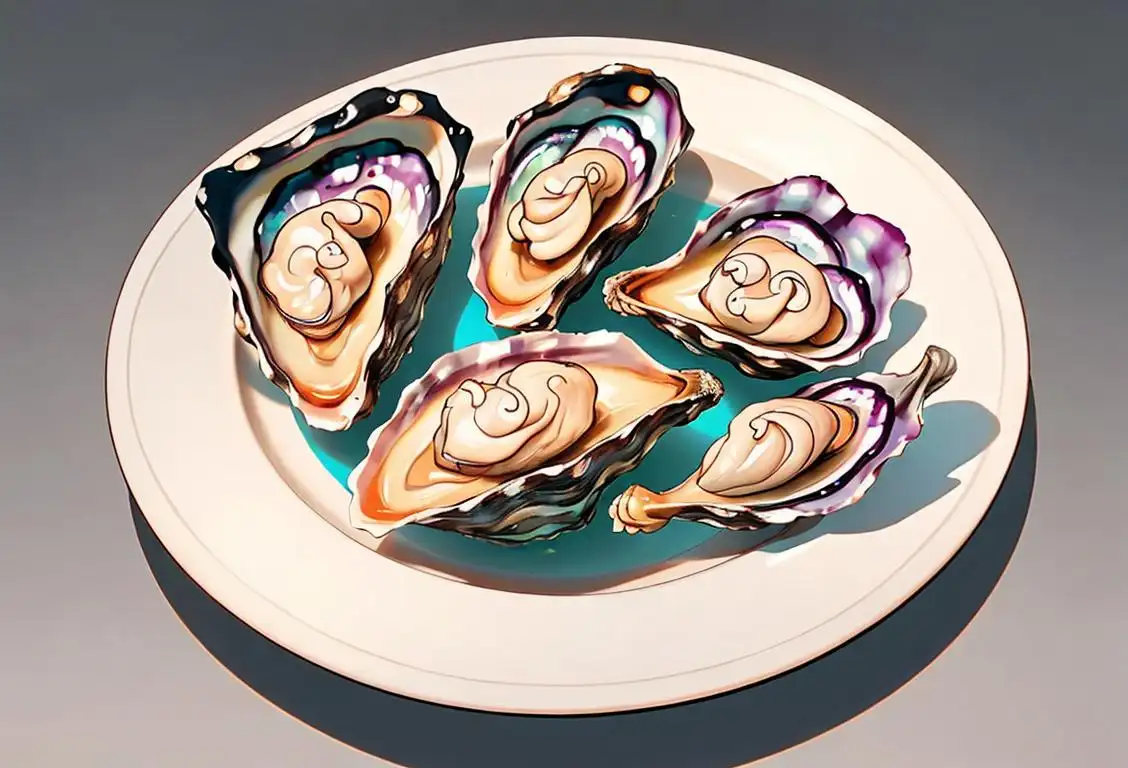National Oysters On The Half Shell Day

Ah, National Oysters on the Half Shell Day, a shellebration of the exquisite delicacy that comes straight from the sea! Get ready to slurp and savor those slimy succulents because today is all about indulging in the briny goodness of oysters. So, grab your lemon wedges and hot sauce, because we're going on a shellfish adventure!
When is Oysters On The Half Shell Day?
It's national oysters on the half shell day on the 31st March.
A Brief Journey into the History of National Oysters on the Half Shell Day
While the origins of National Oysters on the Half Shell Day may be murky, one thing's for sure – oyster lovers around the world are rejoicing every year on this shuck-tastic occasion. Oysters have long been regarded as an extravagant and aphrodisiacal treat, making them perfect for celebrations of all kinds.
Whether you fancy them raw or cooked, oysters on the half shell offer a unique sensory experience. The combination of the silky smooth texture and the briny burst of flavor creates a taste sensation that seafood enthusiasts can't resist.
It's a day to gather with loved ones, don your fanciest attire, and indulge in these delectable treasures from the deep. Many restaurants and seafood joints are likely to have special promotions or menus featuring oysters on this gastronomic holiday.
Did You Know?
Did you know that oysters can change their gender multiple times throughout their lives? Talk about being adaptable! They start off as males and eventually transition to females, but they can switch back and forth depending on the environmental conditions. Oysters are truly the gender-fluid champions of the sea.
History behind the term 'Oysters On The Half Shell'
Early 19th century
Raw oysters gain popularity
In the early 19th century, raw oysters started gaining popularity as a delicacy among the working class in the United States. Oysters were plentiful, affordable, and easy to obtain, making them a favorite choice for a quick and satisfying meal.
19th century
The rise of oyster consumption
During the 19th century, oysters became increasingly popular as a delicacy and a staple food item. Oysters were abundant in coastal areas and were easily accessible, making them a favorite among both the working class and the upper class. People enjoyed oysters in various forms, such as fried, stewed, and pickled. One of the most popular ways to consume oysters was on the half shell, which involved serving them raw with their shells halved.
1800s
The birth of the oyster bar
In the 1800s, the first oyster bars began to appear in the United States. These bars specialized in serving oysters that were shucked, or opened, and served on the half shell. Oysters were plentiful, affordable, and became a staple food in coastal cities like New York, Boston, and Baltimore. The practice of serving oysters on the half shell became popular as it allowed people to enjoy the raw delicacy without any additional cooking.
19th century
The Birth of Oysters on the Half Shell
In the 19th century, oysters became popular as a delicacy in America. They were often served raw and chilled on the half shell, meaning they were shucked and served in their own bottom shell. Oysters on the half shell quickly gained popularity due to their fresh and unique taste.
Unknown
Discovery of oyster as food source
Oysters have been consumed as a food source by humans for thousands of years. Archaeological evidence suggests that oysters were consumed as far back as prehistoric times, with oyster shells found in ancient human settlements.
17th century
The Beginnings of Oyster Consumption
Oyster consumption can be traced back to the early 17th century when colonists arrived in America. Native American tribes had long been enjoying this flavorful seafood delicacy. The colonists quickly recognized the abundance of oysters in the estuaries and coastal waters and began incorporating them into their diets. However, during this era, oysters were typically consumed cooked rather than on the half shell.
1840
The popularity of raw oysters rises
During the mid-19th century, raw oysters became increasingly popular in the United States due to their abundance and affordable price. They were considered a delicacy and were commonly consumed in cities along the coast and major waterways.
18th century
First appearance of the term
The term 'oysters on the half shell' originated in the 18th century as a way to describe a popular method of serving oysters. It refers to the practice of shucking an oyster and placing it back in its half shell, which is then garnished or seasoned to enhance the flavor. This method of serving oysters became widely popular in coastal regions and port cities where oysters were abundant and easily accessible.
19th century
Opening up the oyster industry
In the 19th century, the demand for oysters surged in the United States due to their increasing availability and affordability. The oyster industry boomed, and oyster beds were harvested off the Eastern and Gulf coasts. The increased supply led to the development of various preparations, including oysters on the half shell.
18th century
Oysters Reach New Heights of Popularity
In the 18th century, oysters gained immense popularity, particularly in the coastal cities of the eastern United States, such as New York, Boston, and Philadelphia. Oyster consumption was especially prevalent among the working class due to the affordable price and abundant availability. Oyster cellars and saloons became common establishments, where people would gather to indulge in oyster feasts.
19th century
Growth in popularity
During the 19th century, 'oysters on the half shell' gained significant popularity as a delicacy among social elites. Oyster bars and restaurants specializing in fresh oysters became fashionable gathering places for the upper class. The term became firmly established as a culinary descriptor for this specific style of oyster preparation, and it continues to be widely used today.
1870
The introduction of oysters on the half shell
In the 1870s, the term 'oysters on the half shell' emerged to describe a specific serving style of raw oysters. It refers to oysters that are served with one shell removed, exposing the succulent meat while still being nestled in the other half of the shell.
Early 20th century
The invention of the oyster knife
In the early 20th century, the invention of the oyster knife made it easier to shuck oysters. This thin-bladed knife with a pointed tip allowed people to pry open the oyster shells more efficiently and safely, revealing the succulent meat within. The introduction of the oyster knife further contributed to the popularity of oysters on the half shell, as it made the process of shucking oysters more accessible to the general public.
Mid-19th century
The half-shell method emerges
As the demand for oysters grew, sellers needed a way to present the oysters that would be both convenient for the customers and showcase the freshness of the seafood. In the mid-19th century, the half-shell method emerged. This method involved shucking the oysters and serving them on the half shell, creating an elegant and visually appealing presentation.
Late 1800s
Oyster Bars and Street Vendors
During the late 1800s, oyster bars and street vendors started popping up in major cities across the United States. These establishments offered oysters on the half shell as a quick and delicious snack or meal. Oyster bars became popular gathering spots, known for their lively atmosphere and fresh seafood offerings.
Late 19th century
Introducing oysters on the half shell
Oysters on the half shell gained popularity as a delectable way to enjoy fresh oysters. The term refers to raw oysters that are served on the curved, deeper half of the shell. This presentation allowed oyster enthusiasts to appreciate the briny flavors and unique textures of the raw delicacy.
Early 1900s
Raw oysters gain popularity
During the early 1900s, the popularity of raw oysters continued to grow. Oysters were considered a delicacy and were enjoyed by people from all walks of life. Oyster bars and seafood restaurants became popular destinations, and the term 'oysters on the half shell' became more widely known. This term refers to the practice of serving oysters with one shell intact, while the other half is removed to expose the succulent meat inside.
Ancient Times
Oyster cultivation in ancient Rome
The ancient Romans are renowned for developing advanced techniques in oyster cultivation. They built elaborate oyster farms called 'ostreae' in the Mediterranean, using wooden stakes to create artificial oyster beds. This allowed the Romans to enjoy oysters on a large scale.
Late 19th century
Oysters become a symbol of prosperity
By the late 19th century, oysters on the half shell had become a symbol of prosperity and luxury. They were frequently served in high-end restaurants and were associated with fine dining and social gatherings. Oysters were considered a sophisticated delicacy that was both delicious and impressive, further contributing to their popularity.
1890
Oyster bars gain popularity
Around the late 19th century, oyster bars and saloons started to thrive in urban areas, becoming known as gathering places for socializing and enjoying seafood. Oysters on the half shell became a popular menu item in these establishments, further contributing to the term's usage and recognition.
Early 20th century
The rise of oyster bars
With the success of oysters on the half shell, oyster bars became prominent across the United States. These establishments specialized in serving fresh oysters and became social hotspots. Oyster bars provided a convivial atmosphere where patrons could enjoy oysters on the half shell alongside other seafood options.
19th century
Oysters on the Half Shell Emerge
It wasn't until the 19th century that oysters on the half shell made their entrance. With the development of efficient oyster harvesting techniques and advancements in transportation, oyster beds were more easily accessible. Oysters began to be served raw on the half shell, providing a new, refreshing culinary experience for seafood enthusiasts.
17th Century
The rise of oyster saloons
In the 17th century, oysters gained immense popularity in Europe, especially among the affluent. Oyster saloons, dedicated establishments serving oysters, began to emerge in major cities like London and Paris. These saloons became trendy social gathering spots for the elite.
20th century
Oyster revival
In the early 20th century, oysters faced a decline due to overharvesting, pollution, and disease outbreaks. However, efforts were made to restore oyster populations and their habitats. This led to an oyster revival, and 'oysters on the half shell' regained popularity as a culinary delicacy. Oyster festivals and oyster bars became prominent cultural events, celebrating the rich history and tradition of oyster consumption.
Early 1900s
The Great Oyster Boom
The early 1900s marked the peak of the oyster industry in America. The demand for oysters on the half shell soared, leading to an increase in oyster production and consumption. Oysters were now available year-round and were enjoyed by people from all walks of life.
Mid-20th century
The rise of oyster bars
By the mid-20th century, oyster bars began to emerge as popular establishments. These bars were dedicated to serving fresh oysters, often featuring oysters on the half shell as one of their main offerings. Oyster bars became gathering places for oyster lovers, where they could enjoy the briny and delicate flavors of oysters in a lively and social atmosphere. The rise of oyster bars further solidified the place of oysters on the half shell in culinary culture.
Mid-1900s
Oysters become a symbol of luxury
In the mid-1900s, oysters on the half shell gained further prominence and became associated with luxury and extravagance. Oyster bars became trendy spots for socializing and enjoying fresh seafood. The term 'oysters on the half shell' became synonymous with elegance and refinement, often featured on upscale restaurant menus and at high-end events. People began to appreciate that raw oysters have a unique flavor profile and are packed with nutrients.
Present Day
Oysters on the half shell remain a beloved delicacy
Today, oysters on the half shell are still a beloved delicacy enjoyed by seafood lovers all around the world. Oyster festivals and competitions are held annually to celebrate the oyster culture. The term 'oysters on the half shell' has become ingrained in culinary vocabulary, describing the art of serving raw oysters with their delicious briny taste intact. From casual seafood shacks to upscale dining establishments, oysters on the half shell continue to be cherished and appreciated for their unique flavor and cultural significance.
20th century
Oysters on the half shell become a national favorite
During the 20th century, oysters on the half shell continued to be enjoyed by people across the United States. As transportation and refrigeration improved, oysters became more accessible to a wider audience. Oyster bars and seafood restaurants prominently featured oysters on their menus, ensuring their status as a national favorite.
Early 20th century
Oyster Bar Culture Flourishes
During the early 20th century, oyster bar culture thrived in the United States. Oyster bars, often located in bustling metropolitan areas, became fashionable gathering spots. They attracted people from all walks of life, offering a lively atmosphere and an array of oyster delicacies. Oysters on the half shell became a quintessential menu item, representing both indulgence and sophistication.
Present day
Continued popularity and culinary innovation
Oysters on the half shell remain a beloved dish in modern times. They are often associated with special occasions, events, and coastal regions with thriving oyster industries. Oyster farmers and chefs continue to experiment with new flavor combinations and serving techniques, adding a contemporary twist to this timeless classic. Oysters on the half shell have not only become a symbol of refined dining but also play a significant role in highlighting sustainability and the importance of preserving our marine ecosystems.
Mid-20th century
Oysters on the Half Shell as a Signature Dish
By the mid-20th century, oysters on the half shell had firmly established themselves as a signature dish in seafood restaurants and fine dining establishments. It became a symbol of indulgence and a gourmet treat. Oysters on the half shell were often paired with champagne or a zesty mignonette sauce to enhance their flavors.
1920s
Oysters on the half shell during Prohibition
During the Prohibition era in the United States (1920-1933), the consumption of alcoholic beverages was illegal. However, oyster bars continued to thrive as they were not subject to the same restrictions. People flocked to oyster bars and indulged in oysters on the half shell, enjoying their favorite delicacy while listening to live music.
Early 19th century
Introduction of the half-shell serving style
The concept of serving oysters on the half shell, where the oyster is shucked and presented in its own shell, emerged in the early 19th century. This method of serving provided a convenient and visually appealing way to enjoy oysters. It also allowed for easier consumption and enhanced the oyster's flavors.
Present
Culinary tradition and cultural significance
Today, 'oysters on the half shell' have become an integral part of various culinary traditions around the world. They are often associated with celebrations, special occasions, and coastal cuisine. Oyster farms and sustainable harvesting practices help ensure the availability of fresh oysters, contributing to the continued enjoyment and cultural significance of 'oysters on the half shell'.
1920
The rise of oyster shucking contests
During the 1920s, oyster shucking contests became popular events, often held at oyster festivals and celebrations. These contests involved skilled shuckers competing to open oysters quickly and perfectly. Oysters on the half shell served as the main subject of these contests, showcasing the artistry and skill required to present a perfectly shucked oyster.
Present Day
Continued Love for Oysters on the Half Shell
Oysters on the half shell have stood the test of time and remain a beloved culinary delight. They are often served with accompaniments such as lemon wedges, mignonette sauce, or hot sauce, enhancing their rich flavor profiles. Oyster festivals and events celebrating this delectable shellfish have become popular worldwide, celebrating the ongoing cultural significance of oysters on the half shell.
1970
Oysters on the half shell go mainstream
In the 1970s, with the growth of global culinary influences and the rise of fine dining establishments, oysters on the half shell gained widespread recognition and popularity. They became a staple on menus in upscale seafood restaurants and were embraced by diners looking for a luxurious and indulgent dining experience.
Late 19th century
Oyster bars and pushcart vendors
Oyster bars and pushcart vendors became prominent in urban areas during the late 19th century. These establishments catered to a wider range of social classes, making oysters more accessible to the general population. Oysters on the half shell became a popular street food and a beloved part of urban culture.
Present day
Oysters on the half shell as a classic dish
Oysters on the half shell have stood the test of time and remain a classic dish served in seafood restaurants and oyster bars worldwide. They are typically accompanied by cocktail sauce, mignonette sauce, or a squeeze of lemon. Oysters on the half shell continue to captivate food enthusiasts with their natural brininess and luxurious flavor.
Present Day
Continued Popularity and Cultural Significance
Oysters on the half shell remain a beloved culinary tradition and a source of regional pride in coastal areas around the world. They are often associated with celebrations, special occasions, and luxury dining experiences. Oysters are not only enjoyed for their taste but also recognized for their environmental benefits, as they filter water and contribute to the health of marine ecosystems.
Modern Era
Continued popularity and culinary significance
Oysters on the half shell have retained their popularity throughout the years and have become a staple of seafood cuisine worldwide. They are often enjoyed raw, accompanied by condiments such as lemon, cocktail sauce, or mignonette. Oysters on the half shell have also become a symbol of luxury and indulgence in fine dining.
Did you know?
Did you know that oysters can change their gender multiple times throughout their lives?Tagged
romance food loved onesFirst identified
31st March 2015Most mentioned on
31st March 2016Total mentions
150Other days
Awareness Day
Prayer Breakfast Day
One Day
Kissing Fried Chicken Day
Opposite Day
Vodka Boyfriend Day
Action Day
Happiness Day
Suicide Prevention Month Day
Family Day









